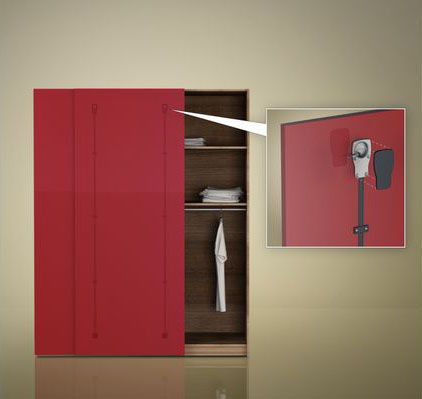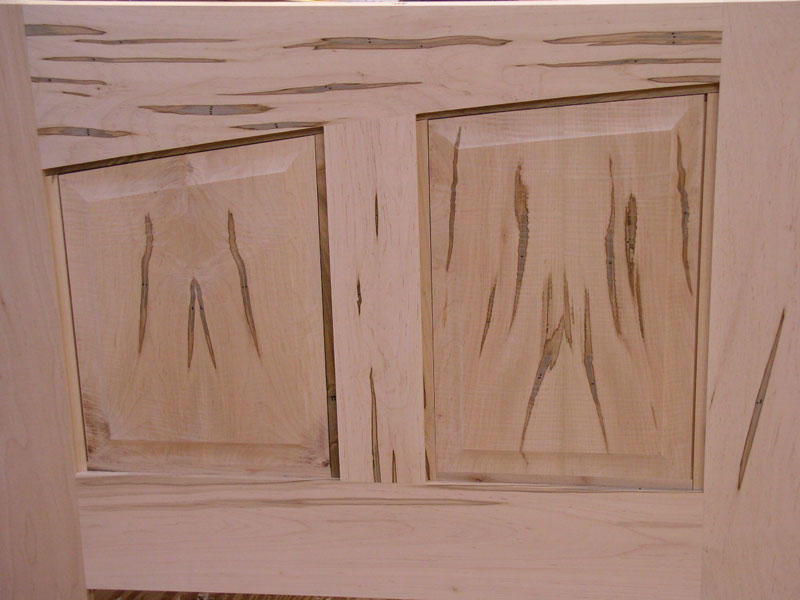Question
I posted a while ago about some 2-1/4" thick doors I built that have started warping. I've been going back and forth with the owner and I think we're on the same page as to liability, (a short recap, doors were not painted properly and still six months plus after delivery some of the edges are not properly coated! One is also on a closet which contains two hot water tanks producing a lot of heat! He has agreed to pay for two of the doors to be replaced.
One has a stile that warped inward at the bottom about 1/2" and I think I will have to re-make that one. The other door has an outside rail that has a bow in it. I had the thought of installing a truss rod (for those of you not familiar, guitars employ a steel rod inserted into a curved recess in the neck which allows you to counteract the forces of the strings by tightening the rod against the curve.) I'm thinking of making a full length truss rod I could insert in the back of the stile and use to pull it straight again. What do you think? It would be significantly easier, quicker, and more profitable than building these doors again. The door in question is a closet door, not the utility room door.

Forum Responses
(Architectural Woodworking Forum)
From contributor D:
I doubt a steel rod will keep a rail from warping. A 10" wide rail 2 1/4" thick will move regardless. If it doesn't bend a rod with it, it will crack around it. You have a tough situation, better solved by insulating the tanks than trying to reinvent the stile and rail door. Still, you could benefit from engineered core in the rails, stiles, and panels as well. Even further, a great moisture barrier before painting is thinned epoxy.

I have had luck ripping off an offending stile and basically re-coping the ends of the rails, but with the applied moulding that creates a new wrinkle and you would have to remove it. I think you are stuck building new ones, maybe you can salvage the panels.
On another note, we have gone back and forth over the years with painters not sealing the bottoms. I put little stickers on all our doors and forward a sheet to the contractor on how to seal and properly care for our doors. Usually it’s to no avail and I’ve been in your position many times, mostly exteriors. I also tried sealing the bottoms ourselves but had an issue with wicking up the end grain on stained doors. It seems that more times than not we eat it trying to maintain a good relationship with our customers.
I should also say the door that looks like it moved 1/2" is likely not off that much, as the jamb was out of plumb almost that much at the top. That was more of an eye measurement using a 6' level, so I'm not sure exactly how much warp there really is yet. Plumbing the jamb is not going to completely get rid of the warp, but it will minimize it a bit. Considering it's got to be close to or over 100 degrees inside the closet vs. 78 outside, I'm surprised only the one warped!
Just as an aside, not only were the bottoms not painted but when you open the other (non-utility) closet doors you can see the edge of the stile still only has my original coat of primer on it. I'm also pretty sure that the faces of the doors have significantly more paint than the backs. The painters have literally been putting coat after coat on all the woodwork in the place. They just keep filling the gaps with caulk and painting. There are gaps in the builtup crown moldings of over 1/8" half filled with caulking, it's a complete mess. I'm going to check the humidity level next trip in as the heat is at a constant 78 degrees. There are now many gaps in the floor also, some close to an eighth of an inch!
Contributor M, my idea was to insert the hardware so it's inside the stile in the same manner they fabricate guitar necks (nothing visible on either side). This client is not going to go for having hardware mounted to the face of the door, even though it's inside a closet. He's already spent well over $1m on this build so given the choice he'll pay for a new door. My problem is more of a time/schedule one as these doors are pretty time consuming to produce.
As for construction the doors are made up with three pieces of 4/4 soft maple milled flat and glued up. Let sit for several days or more then milled again for flat. I glued up the entire batch as full lengths and used the flattest pieces for stiles and cut the rest into rails. I really think the problem is a combination of how dry the unit is getting and how poorly the doors were coated.
I'm now leaning towards just re-making the doors. I don't think ripping the stile off will work. I'd have to remove so much of the moldings and do so much jigging up, it would probably take just as long. I just wanted to run it by you guys first and see what you all thought.
If you put in a truss rod and a wet board continues to dry out/equalize, then you may be making monthly visits to adjust the truss rod. Since the door is paint grade, the problem stile can be ripped off in 90% of its width and replaced, or routed down on each face and then replace with new wood. This should avoid making a new door.
Plumb vs. flat: I go only so far with levels and this whole plumb discussion - plumb is a subjective term. I do not think a door hung 1/8" out of plumb will warp (especially at 2-1/4" thick). The only way to tell if the door and the jamb are flat is to string them. Stretch a taut string from corner to corner, coming right off the face of the jamb, or blocked up equally on the door, diagonally so that the two strings cross each other in the center. They should just touch, telling you that all four corners are in the same plane. If they miss by 1/8", then one corner is out twice that - 1/4".
I have seen many times where an irritated carpenter slams his level up against one jamb, then the other, saying 'plumb' at each, when the jamb indicates a twist of over 1/8". Correct this and the problem goes away. This problem is magnified in paired doors.
So then we brought in a laser to check the planes of the opening more accurately, and the top corner of the jamb was off by close to 1/2"! So when they pull that jamb back into where it's supposed to be, it should better indicate how bad the door really is. I do still think that door may need to be replaced since at first glance it does seem warped – the bottom pulled in towards the closet. I wouldn't think just replacing the stile will solve that issue?
On the other door I'm thinking about the truss rod for, (non-utility closet), the stile is actually bowed, so possibly a fixable situation. Of course the two doors which have problems are both in paired situations making it even more obvious!
I would like add I have adjusted many doors in this fashion either for slight warping, walls out of plumb, structures moving and settling, etc. and it is absolutely acceptable. As for the success rate you are batting around 15%, not very good. I know the debate rages on, solid, or stacked solid, but these doors for me wood have been poplar on a fingerjointed pine core 1/8" veneers. You have way to much solid material all fighting to do what it wants to do.
Normally I'd be very discouraged having 2 doors out of 14 warp on me. Keep in mind though that the way these doors were handled, painted, and installed would void pretty much any reputable door manufacturer’s warranty! Had I known about the utility room beforehand I'd probably have opted for stave core on those particular doors. That's what happens though when a homeowner decides to design on the fly!
I had also though about moving the hinges, but because of the buildup casings I'm very limited to how much I can move. Anything more than say a 16th of an inch will be noticeable. I'm going back end of the week for another small project and will see if they fixed the jamb. I will also bring some blocks and string to check how bad the warped door really is.
